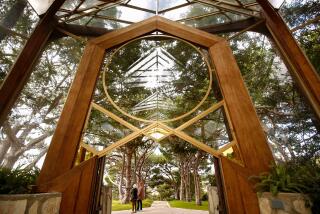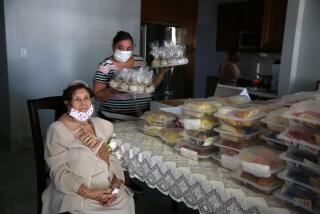Tradition-Filled Burial Held for Evelyne Pope Forster : Funeral: Procession and services are held in San Juan Capistrano for member of one of the county’s venerable families.
- Share via
SAN JUAN CAPISTRANO — A member of one of the county’s oldest families was laid to rest amid pomp and tradition Saturday, even prompting Mission San Juan Capistrano to reopen its 210-year-old Serra Chapel--closed for repairs--in deference to a centuries-old custom.
Evelyne Pope Forster was buried after Mass was said in the chapel and priests led a procession of family and friends who walked through the streets of San Juan Capistrano to the cemetery.
The morning service for the member of the venerable family was steeped in tradition that predates even the Forsters’ earliest arrival in San Juan Capistrano in 1833.
“The tradition reserved for the oldest families here is really unique,” said Msgr. Paul M. Martin, pastor of the church. “And it is really those old families that keep them alive.”
Two weeks ago the chapel was closed for earthquake safety renovations. The roof has been torn off, allowing sunlight to peek through the rafters onto the mourners Saturday.
After the service, friends and family members filed onto the street for a short procession which ended on a hill at the Old Mission Cemetery, overlooking the chapel. There, about 40 Forsters are buried beside the graves of some of the area’s oldest Latino and American Indian families.
Forster, who died Friday of cancer at age 81, was laid to rest in a corner plot beside her husband, George, who died four years ago. George Forster was a great-grandson of Don Juan Forster, an early Orange County rancher who emigrated from England to this area in 1833. The elder Forster at one time even owned the mission.
Evelyne Pope Forster married into the family in 1931. She was the first kindergarten teacher at the Mission School, built in 1954 on the grounds of Mission San Juan Capistrano. She was also a past president of the San Juan Capistrano Women’s Club and was active in the San Juan Capistrano Historical Society and other organizations.
Family members said that the funeral procession, about three blocks long, originated with the first Spanish and Mexican settlers to San Juan Capistrano, but has changed dramatically over the years.
“I can remember when there were only about 500 people in town” in the 1940s, said John Forster, son of Evelyne and George. “The whole town was involved in those early processions.”
Saturday’s procession began after about 120 people emerged from the chapel. Orange County sheriff’s deputies blocked off traffic on El Camino Real and a two-block stretch of Ortega Highway.
Church bells tolled as the funeral group paced slowly down the street, turned onto Ortega Highway to cross Interstate 5, and then turned again to trudge up the dirt road to the cemetery. In the center of Saturday’s procession was the hearse carrying the casket, escorted by six pallbearers and dozens of family members.
The cemetery grounds were filled with gravestones marking the resting places of at least six generations of early San Juan Capistrano families.
After the casket was lowered into the ground and prayers were recited, family and friends tossed handfuls of dirt into the grave.
“There is a lot of pride,” John Forster said. “These traditions give us a real sense of family that goes back many years.”
More to Read
Sign up for Essential California
The most important California stories and recommendations in your inbox every morning.
You may occasionally receive promotional content from the Los Angeles Times.










